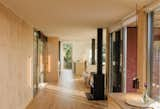The Spanish company says its glassy, steel-framed homes start at around $300 per square foot.



View 9 Photos
Welcome to Prefab Profiles, an ongoing series of interviews with people transforming how we build houses. From prefab tiny houses and modular cabin kits to entire homes ready to ship, their projects represent some of the best ideas in the industry. Do you know a prefab brand that should be on our radar? Get in touch!
Architects Ignacio de la Vega and Pilar Cano-Lasso would get the same question from their clients time and again. Not with regards to design elements, but with pricing: what was their home going to cost? Because traditional construction makes a total hard to predict with complete accuracy, the duo founded a prefab company in 2019, Tini Living, which offers six models that can be arranged in different ways to create bespoke homes. And the pricing is all up front.
Now, the company is shipping its homes to the United States. Their latest project, in Segovia, Spain, actually bridges the gap between Europe and the States by referencing Los Angeles’s Case Study Houses. It combines several units to form an elongated, steel-framed plan that’s inspired by California modernism.
“Our philosophy has always been clear: true luxury is not about grand gestures, but about quiet, essential presence,” says de la Vega. “A home should embrace, not interrupt. Every Tini project reflects this ethos with pure lines, noble materials, fluid transitions between inside and out, and a process that’s as transparent as it is livable.” Here’s how Tini Living says it plans to deliver on that promise.


What qualities make your prefab designs stand apart from others?
We believe that designing a home means designing a way of living. At Tini Living, we don’t offer products, we offer a way of making architecture with honesty, permanence, and purpose. After years of developing bespoke projects with our industrialized building system, we have distilled everything we’ve learned into a series of optimized, replicable homes.

Get the Pro Newsletter
What’s new in the design world? Stay up to date with our essential dispatches for design professionals.
We believe these houses are designed to the highest architectural standards—far from traditional prefab catalogs, and close in spirit to the Case Study Houses. Each model is conceived as a “case study” that’s proportioned, oriented, and connected to the landscape. This approach offers access to thoughtful architecture through a fast, technically supported process.
Lastly, we’ve developed our own industrial method based on a steel frame, building information modeling (BIM), full in-factory manufacturing, and total cost control, and we work with high-quality local materials and advanced insulation systems to ensure maximum energy efficiency.


Beyond this new home outside Madrid, what’s another of your favorite projects?
One of our most emblematic projects, and one that perfectly reflects our vision of serene architecture, is Tini Menorca. Built entirely in our factory in just 100 days and installed on-site in one day, it was awarded the 2025 MATCOAM Prize for innovative architectural rigor.
The home is located on a sloping site in Menorca and is designed in a T-shape to maximize natural light and views of the Mediterranean. It respects the vegetation by integrating trees into the architectural flow, and applies passive systems such as pergolas for shading and natural ventilation. The clients love how the design merges with the landscape and creates a peaceful, light-filled retreat.

What does your base model cost and what does that pricing include?
Our pricing varies depending on the size of the project and the finishes selected. Typically, the cost starts at around €2,800 per square meter, which is approximately $305 per square foot. We aim to offer clarity and transparency in pricing, which our clients deeply appreciate.

Where are your homes currently available?
We build in our own factories in Spain. For international projects, including in the United States, we manage the entire shipping process to ensure quality and control.
Are any of your prefab designs currently pre-permitted in any U.S. municipalities?
Our designs comply with U.S. regulations, and our construction system has successfully passed certification processes in California and New York.

How long can a client expect the process to take after they put down a deposit?
The first step is the design phase. Once the design contract is signed, we assign a dedicated team—including architects, engineers, and technical experts—who will accompany the client throughout the entire process. After finalizing the design, we manage state-level certifications through authorized agencies, and then build the Tini in just 100 days. Our clients often highlight speed and predictability as key benefits.

What aspects of an install do you manage?
We work with local partners in the U.S. who help us provide a full-service installation. They handle local permitting and coordinate qualified contractors to complete all necessary site work, including foundation installation and electrical and water hookups. This allows us to deliver a seamless and integrated process for our clients.

What aspects of the design can a client customize?
Clients can customize the facade, interior wall and floor materials, and equipment such as wardrobes, bathroom fixtures, and HVAC systems.

More Prefab Profiles:
This Breezy Brazilian Prefab Is Made From Six Tiny Modules
These $31K Micro Cabins Are Light Enough to Be Dropped Into Place by a Helicopter
Published
Last Updated